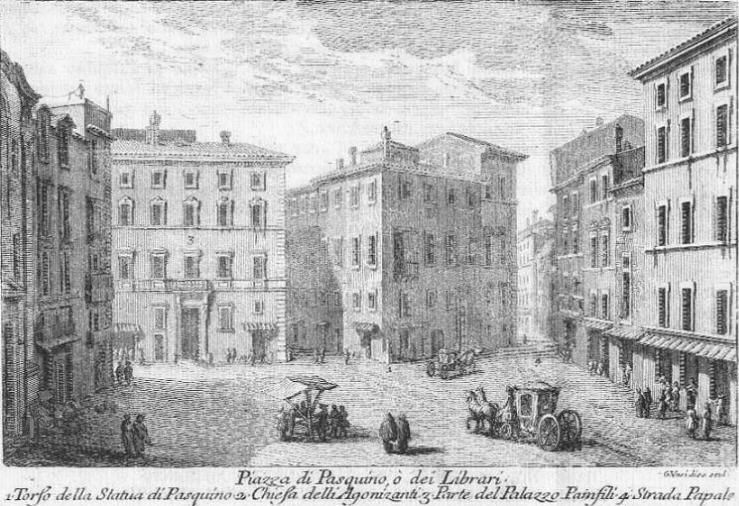  Piazza di Pasquino (Book 2) (Day 4) (View C6) (Rione Parione) In this page:
Piazza di Pasquino is a small square near Piazza Navona known for
the torso of a statue representing Menelaus with the body of Patroclus,
but known as Pasquino after the name of a tailor who lived nearby
and who had a reputation for lampooning. In the plate however the statue
is almost invisible. The view is taken from the green dot in the small 1748 map here below.
In the description below the plate Vasi made reference to: 1) Statua di Pasquino;
2) S. Maria degli Agonizzanti; 3) Palazzo Pamfili; 4) Strada Papale (the street by which the Pope from St Peter's reached S. Giovanni in Laterano to take possession of his bishopry). 3) is shown in more detail in another page. The small map shows also: 5) Palazzo dei Ritratti.
The buildings behind the statue were pulled down a few years after the plate to erect Palazzo Braschi, the family Palace of Pius VI. To the left the façade of S. Maria degli Agonizzanti and in the front the back of Palazzo Pamfili in Piazza Navona.
The most famous of the talking statues of Rome is still used from time to time for posting messages and claims. Usually Pasquino talked with Marforio, more occasionally with Madama Lucrezia, Abate Luigi, il Facchino and il Babuino (click here to learn more about Pasquino and the Talking Statues of Rome). In Loggia della Signoria in Florence there is another Roman copy of the ancient Greek statue: it was found in Rome in the XVIth century and brought to Florence where it was amply restored. It is one of many works of art moved from Rome to Florence (see my Florentine Recollections).
The church, in origin just a chapel for the members of a brotherhood who assisted those who were sentenced to death
(hence the name agonizzanti), was given a new façade in 1862.
The coat of arms of Pius VI was recently cleaned but it has lost its lower part with the representation of Borea, a strong wind (my background for this plate, copied from a relief in the inner court of the Palace, shows Borea). The palace was built by Girolamo Onesti the brother-in-law of pope Pius VI. He added to his surname the surname of the pope (Braschi) so the palace should be called Onesti Braschi, but because Onesti means honest in Italian the double name sounded inconsistent with the fame of the relatives of the pope. The palace is also decorated with a lion holding a pine-cone in his mouth, the heraldic symbol of the Onesti family. Learn more about Pius VI by clicking here. The façade of Palazzo Braschi is shown in the next step of this itinerary.
This section of Strada Papale is now called Via del Governo Vecchio after the palace by the same name. It was one of the most important streets of Rome and many palaces show the wealth of their owners. Palazzo dei Ritratti (portraits) is the name usually given to a palace decorated with paintings (XVth century) and reliefs showing great lawyers of the past (XVIIIth century).
Many houses in the narrow streets near Piazza di Pasquino retain an indication of their former owners:
the dove of the Pamphilj is obviously on many buildings as this family owned most of the estates near
Piazza Navona.
In some cases we can even learn that a house that belonged to the Matuzzi (rampant lion) was bought by the Peretti who added a crown of small pears (another symbol of the family). But there is no memory of the owner of the gentle lion who greets with an olive branch those who enter another small palace. Excerpts from Giuseppe Vasi 1761 Itinerary related to this page:
Next plate in Book 2: Piazza di S. Pietro in Vaticano Next step in Day 4 itinerary: Palazzo Massimi Next step in your tour of Rione Parione: Palazzo Massimi
Go
to |
All images © 1999 - 2003 by Roberto Piperno. Write to romapip@quipo.it











